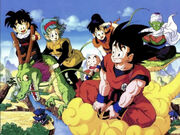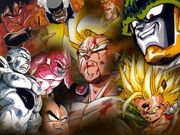Dragon Ball Z follows the adventures of the adult Goku who, along with his companions, defends the earth against an assortment of villains ranging from intergalactic space fighters and conquerors, unnaturally powerful androids and near indestructible magical creatures. While the original Dragon Ball anime followed Goku through childhood into adulthood, Dragon Ball Z is a continuation of his adulthood life, but at the same time parallels the maturation of his son, Gohan, as well as characters from Dragon Ball and more. The separation between the series is also significant as the latter series takes on a more dramatic and serious tone. The anime also features characters, situations and back-stories not present in the original manga.
Production history

The main characters of Dragon Ball Z
The other names the production was considering for this second series before they settled on Dragon Ball Z were Dragon Ball: Gohan's Big Adventure, New Dragon Ball, Dragon Ball 2, Dragon Ball Wonder Boy, and Dragon Ball 90.[1] The anime first premiered in Japan on April 26, 1989 (on Fuji TV) at 7:30 p.m. and ended on January 31, 1996. The series average rating was 20.5%, with its maximum being 27.5% (Episode 218) and its minimum being 12.1% (Episode 273). Like Dragon Ball, the music for Dragon Ball Z was composed by Shunsuke Kikuchi. The character designs for Dragon Ball Z were created by Minoru Maeda from the Raditz Saga to the Cell Games Saga and Katsuyoshi Nakatsuru from the Great Saiyaman Saga to the Kid Buu Saga.
Toriyama's humor/parody manga Nekomajin, released after Dragon Ball and Dragon Ball Z, features several concepts introduced in the series, and several Dragon Ball Z characters make various appearances in this manga. After Dragon Ball Z, the story of Goku and friends continues in the anime-only series Dragon Ball GT, which is not based on a manga by Akira Toriyama, but is a project by Toei Animation using the same characters and storyline that serves as a sequel to Dragon Ball Z. 19 years after the end of Dragon Ball Z in Japan, a new sequel series titled Dragon Ball Super premiered with original concepts by Akira Toriyama, taking place after the death of Kid Buu but before Dragon Ball Z's ending.
In the U.S., the series initially aired in first-run syndication from September 13, 1996 to May 23, 1998, and then aired on Cartoon Network's Toonami block from August 31, 1998 to April 7, 2003, though not always with the same continuity of dubbing (for details on the dubbing problems, see Ocean Group dubs and Funimation dub). In was also shown in Canada on YTV around the same time. It aired in the UK, with the same dubbing problem, on Cartoon Network, premiering on March 6, 2000 and running on that channel until 2002. The Majin Buu Saga, Fusion Saga and Kid Buu Saga were later broadcast on CNX, which later changed its name to Toonami, with the show ending on February 28, 2003. After the finished run, it was repeated daily, until Toonami merged with Cartoon Network Too. In Australia it was shown on both Cartoon Network and the Australian Broadcasting Corporation with Cartoon Network airing it in around 1997-1999 and ABC from 1999-2004. In New Zealand it was shown in TV3.
In April 2009, a new 'refresh' of Dragon Ball Z began airing on Japanese television. This re-cut is titled Dragon Ball Z Kai.
Censorship issues
Dragon Ball Z was marketed to appeal to a wide range of viewers from all ages, and contains crude humor and occasional excesses of violence which are commonly seen as inappropriate for younger audiences by American standards. When it was first marketed in the US, the distribution company Funimation alongside Saban decided to initially focus exclusively on the young children's market, because the anime market was still small compared to the much larger children's cartoon market. This censorship often had unintentionally humorous results, such as changing all references to death so the dead characters were merely going to "another dimension", and digitally altering two ogres' shirts to read "HFIL" instead of "HELL".
Starting with the Captain Ginyu Saga on Cartoon Network, censorship was reduced due to fewer restrictions on cable programming. Funimation did the dubbing on their own this time around with their own voice actors. In 2004, Funimation began to redub the first two sagas of Dragon Ball Z, to remove the problems that were caused from their previous partnership with Saban. They also redubbed the first three movies.
However, the show still retained some level of censorship, not out of FCC laws, but out of choice by Funimation, so as to cater to the possible sensitivity of western audiences. For example, Mr. Satan was renamed "Hercule" to avoid any religious slurs; his daughter, Videl, was a play on the word "Devil", but Funimation felt that the connection was obscure enough to not worry about.
Filler and differences from the manga
Main article: Filler

Some of the series' main heroes and villains
Filler is used to pad out the series for many reasons; in the case of Dragon Ball Z, more often than not, it was because the anime was running alongside the manga, and there was no way for the anime to run ahead of the manga (since Toriyama was still writing it, at the same time).
The company behind the anime, Toei Animation, would occasionally make up their own side stories to either further explain things, or simply to extend the series. Filler does not come only in the form of side stories, though; sometimes it is as simple as adding some extra attacks into a fight. One of the more infamous examples of filler is the Frieza Saga. After Frieza had set the planet Namek to blow up in five minutes, the final fight between Goku and Frieza still lasted well over five episodes, much less five minutes, although this can be attributed to the fact that Namek simply took longer to explode than Frieza expected. Also, there were many numerous filler scenes that took place while the battle with Frieza was in motion, which accounts for much of the footage during the planet's explosion.
As the anime series was forced to expand 12 pages of manga text into 25 minutes of animation footage, these changes were introduced to kill time or to allow the (anime) writers to explore some other aspect of the series' universe. The Garlic Jr. Saga (Garlic Jr.'s return from the Dragon Ball Z: Dead Zone movie) between the Frieza Saga and Trunks Saga, and the Other World Tournament between the Cell Games Saga and the Majin Buu Saga are both good examples of this.
Besides having filler scenes and episodes, there are many other changes from the original manga. Among them are the following:
- When Tien Shinhan loses his arm while fighting Nappa, his arm becomes a stump with only a small amount of blood seen. In the manga, the scene is much more gory.
- In the manga, Frieza kills Cargo, but in the anime Dodoria kills him.
- In the manga, Zarbon informs Vegeta about Frieza's ability to transform during their first fight. This was removed from the anime, but Vegeta still later tells Frieza that it was Zarbon who told him about Frieza's transformation ability.
- In the manga, Appule finds all the Namekians in the village attacked by Vegeta dead and tells Frieza, who just tells him to call the Ginyu Force. In the anime, the soldier is changed to another soldier referred to as "Orlen" in the closed captioning for the Ocean Dub VHS tapes. This soldier is killed by Frieza when he tells that he killed the last survivor of the village without asking him where Vegeta was.
- In the manga, after Frieza survives Goku's Spirit Bomb, he immediately strikes down Piccolo with his Death Beam technique, but in the anime, he fires his beam at Goku, only for Piccolo to jump in the way and get struck down by the beam anyway.
- In the manga, Frieza's full power was still never a match for Goku's Super Saiyan form, but in the anime, Frieza appears to have the upper hand for a short time before he begins to tire.
- In the anime, when Vegeta is brought back to life on Planet Namek, he manages to witness some of the battle between Goku and Frieza, as well as Goku's Super Saiyan form, before being teleported to Earth by the Namekian Dragon Balls. In the manga, he is teleported to Earth almost immediately after being revived and does not get a chance to see Goku as a Super Saiyan for the first time until Goku returns to Earth himself later on.
- When Dr. Gero first appears in the series (as Android 20), he grabs a man by the neck and tears him through the roof of a car. In the original manga, he crushes the man's neck afterwards, tearing his head off.
- In the manga, when Goku fully recovers from the Heart Virus, Chi-Chi finds him simply looking out the window of the bedroom he was resting in at Kame House. In the anime, however, Chi-Chi finds him outside the house, firing several Kamehameha blasts across the ocean.
- During Gohan and Cell's Beam Struggle in the anime, Piccolo, Krillin, Tien, and Yamcha unsuccessfully try to distract Cell before Vegeta succeeds in doing so, whereas in the manga, they all simply observe the struggle and Vegeta is the only one to attack Cell from behind.
- When Vegeta shoots a Galick Blazer at Cell, he is seen in his Super Saiyan form in the anime
